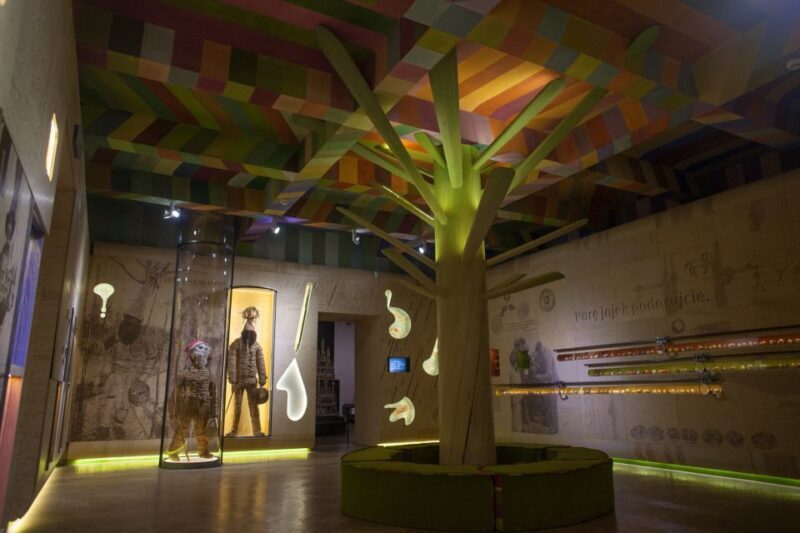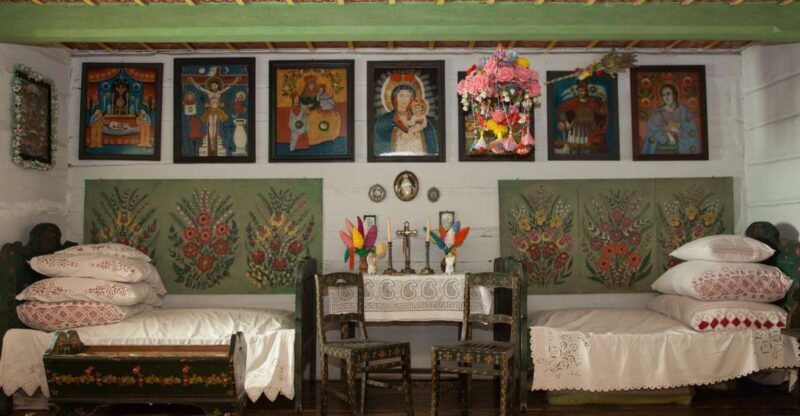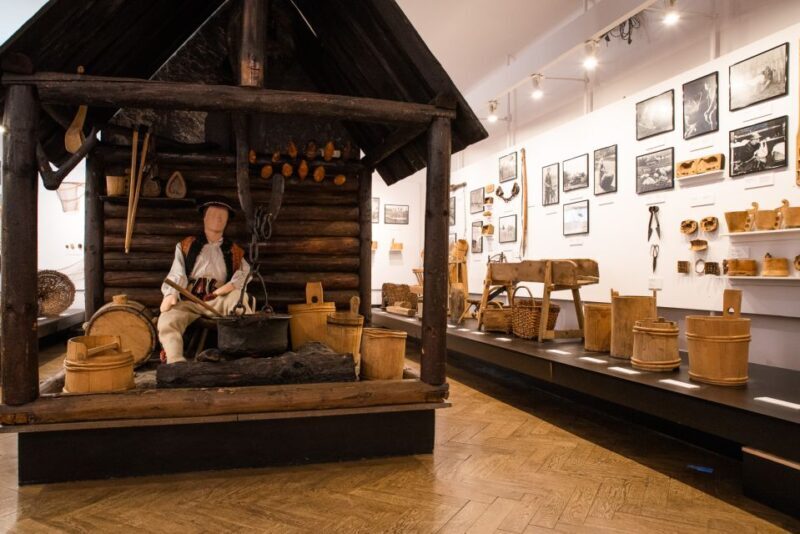Krakow: The Ethnographic Museum Ticket – A Genuine Cultural Window into Poland
Traveling through Krakow, it’s easy to get caught up in the bustling streets and historic squares, but stepping into the Ethnographic Museum offers a different, more intimate perspective on Polish tradition. For just around $4.81, you gain access to an extensive collection that reveals the colorful tapestry of Polish folk art and peasant culture. Open to visitors for one or two days, this museum promises a tranquil yet fascinating journey through Poland’s cultural soul.
We love how the museum is housed in two distinct buildings—the main Town Hall exhibition, which provides a vivid snapshot of local folk culture, and Esterka’s House, with its atmospheric vaulted cellar displaying temporary exhibits. Both spaces are thoughtfully curated, making this a worthwhile stop for those interested in understanding the roots of Polish artistic expression. The price is a real highlight—affordable and offering remarkable value compared to many other cultural attractions in Krakow.
One thing to consider is that the museum doesn’t include guided tours or food and drinks, so if you’re after a more in-depth, guided experience, you might want to plan for additional options. However, if you’re a curious traveler who appreciates self-guided exploration and authentic collections, this experience suits you well. It’s particularly ideal for those wanting a peaceful, enriching cultural break—perfect for history buffs and art lovers alike.
Key Points

Affordable entry with a deep cultural value
Two buildings—the Town Hall and Esterka’s House—for diverse exhibits
Extensive collection—around 80,000 showpieces from the late 19th and early 20th centuries
Authentic insight into Polish folk art and peasant culture
Well-organized experience across multiple floors, praised by visitors
No guide included—a self-paced exploration opportunity
An In-Depth Look at the Ethnographic Museum Experience

If you decide to visit, you’ll find yourself in a space that’s much more than a typical museum—it’s a vibrant showcase of Polish folk artistry and traditions**. Created in 1911 through the efforts of Seweryn Udziela, an amateur ethnographer and collector, the museum’s roots are as authentic as its exhibits. Today, it’s a treasure trove of around 80,000 objects, mostly from the late 1800s to early 1900s, making it a real feast for anyone interested in the visual culture of Poland’s rural communities.
Exploring the Town Hall Exhibition
The main building, the Town Hall, is beautifully arranged across several floors, each dedicated to different aspects of folk life. As you wander through, you’ll see paintings, sculptures, textiles, and everyday objects that illustrate how Polish villagers celebrated, worked, and expressed their identity. Visitors consistently praise the museum’s well-organized layout, making it easy to follow the story of Poland’s peasant culture.
We particularly loved the way the exhibits reflect folklore’s vitality—an antidote to the period’s cultural crisis among Polish intellectuals at the turn of the 20th century. It’s fascinating to see how artists drew inspiration from folklore’s liveliness, capturing the essence of rural life with vibrant colors and intricate craftsmanship. One visitor described the experience as “a great discovery,” especially in the section dedicated to paintings and sculptures.
Esterka’s House and Temporary Exhibits
The second building, Esterka’s House, offers a quieter, more intimate environment. Its vaulted cellar hosts temporary displays, often changing to reflect different themes or aspects of local culture. Visitors appreciating architecture will enjoy the beautifully vaulted ceilings, adding to the sense of stepping back in time. This part of the museum offers a chance to see specialized exhibits that aren’t part of the main collection, providing a dynamic aspect to your visit.
Authenticity and Cultural Significance
The museum’s focus on peasant culture makes it stand out in Krakow’s array of attractions. Here, you’re invited to see the everyday objects and artworks that once formed the core of rural life—an authentic, tangible link to Poland’s past. The collection highlights the attraction artists had to folklore, which they saw as a vital expression of Polish identity.
More Great Tours NearbyVisitor Experiences and Reviews
Recent visitors have praised the museum’s consistent organization and impressive collection. One review notes, “Very well organized on several floors. The last one (paintings, sculptures, etc.) was a great discovery for me.” Others mention the beauty and interest of the exhibits, confirming that this is a rewarding stop for those wanting an authentic cultural experience.
Practical Tips for Visiting
- The ticket price is quite low for such an extensive collection, making it an excellent value.
- The visit duration can range from 1 to 2 days, so you can take your time exploring.
- Check the availability for starting times, as it varies.
- Remember, flash photography isn’t allowed, so bring your camera cautiously.
- As no guided tour is included, you’ll want to plan a self-guided visit or consider bringing a guidebook or app for context.
Is This Tour Right for You?

This experience is perfect for travelers who value cultural authenticity and enjoy self-guided explorations. If you’re interested in art, history, and folk traditions, you’ll find the collection engaging and inspiring. It’s especially suited for those wanting a peaceful, contemplative experience that takes you off the beaten path of Krakow’s more tourist-heavy sites.
If you’re traveling with family, history buffs, or art lovers, this museum offers a quiet yet enriching way to deepen your understanding of Polish culture. Those seeking guided commentary or interactive exhibits might find the experience a bit basic, but for truly absorbing a piece of Poland’s folk art heritage, it’s a standout.
Final Thoughts

The Krakow Ethnographic Museum delivers excellent value for an affordable entrance fee, especially considering its wealth of objects and well-thought-out presentation. It provides an authentic glimpse into rural Poland’s artistic and cultural traditions, making it ideal for curious travelers who want to connect with local customs beyond the usual tourist fare.
Visitors praise its organized layout, stunning exhibits, and insightful displays, all of which contribute to a memorable cultural outing. Whether you’re a dedicated history fan or just want a quiet space to soak in Polish traditions, this museum has much to offer.
For anyone eager to explore Poland’s folk art history firsthand, this is a wonderful choice. It’s a chance to appreciate the vibrancy and craftsmanship of Polish rural life and gain a deeper understanding of how art has shaped national identity over the last century. A peaceful, affordable, and genuinely enriching experience awaits those who choose to visit.
FAQ

How much does the ticket cost?
The entry ticket costs approximately $4.81 per person, offering excellent value for access to a large, well-curated collection.
How long should I plan to stay?
You can expect to spend anywhere from 1 to 2 days, depending on your interest level and pace. The museum is spread across multiple floors, so taking your time makes sense.
Is there a guided tour available?
No, guided tours are not included. The experience is self-guided, so you might want to bring a guidebook or audio guide for additional context.
Are photos allowed?
Flash photography is not permitted, but you can usually take pictures without flash—just be respectful of the exhibits.
What types of exhibits are showcased?
The museum features paintings, sculptures, textiles, and everyday objects that illustrate Polish folk traditions and peasant life.
Can I visit Esterka’s House separately?
Yes, the museum’s buildings are separate, with Esterka’s House offering temporary exhibits in its vaulted cellar, providing a different perspective from the main Town Hall.
In summary, the Krakow Ethnographic Museum offers a quiet, authentic look into Poland’s folk art and rural traditions, accessible at a budget-friendly price. It suits travelers with an interest in cultural history, art, and traditional crafts who enjoy exploring at their own pace. With engaging exhibits and a well-organized layout, it’s a meaningful addition to any Krakow itinerary—especially for those wanting a more personal connection to Polish heritage.
You can check availability for your dates here: